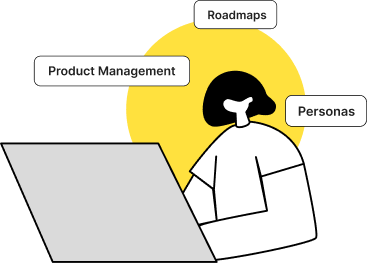When we swipe through our phones, it’s natural to find some apps that are used regularly and some that we haven’t even logged into after installing them. Spotify, an app that doesn’t need an introduction, definitely falls into the first category. An example of a great digital product, it provides an unmatched listening experience as it understands listeners’ tastes and adapts accordingly.
This made me think about how Spotify continues to grow its product and how the company has come up with such mind-blowing features. Then I started thinking of Spotify’s product team hashing out the new features that are to be built and experience-or performance-related aspects that need improvement.
How do product teams do that? Are they superheroes with the superpower to predict the future?
I thought the best way to know this would be by putting myself in the product team’s shoes, and that’s exactly what I did.
First, I created a list of feature requests and improvements expected from Spotify. We’ll construct a roadmap and set priorities for the next two quarters, hypothetically, for the features that we’d like to see in Spotify as a product and as a company (hypothetically).
| 1. Current user count is 380M+ a. Add 1B users to the platform b. Expand to different geographical markets c. Increase the free user to paid user Conversions up by 15% | |||||||||
| 2. The best option for audio quality today is 320 kbps. Other apps like Amazon Music HD are offering over 1440 kbps. | |||||||||
| 3. Create personalized playlists using machine learning for each user + improve the recommendation algorithm (i.e. people listening to Spotify-recommended songs and not skipping them within 5 seconds) | |||||||||
| 4. Improve caching in Spotify iOS app to deliver music better | |||||||||
| 5. Search shows songs, artists, and podcasts. The performance is way below the expected SLA of 0.5 sec. | |||||||||
| 6. Spotify for automobiles. Compatibility and driving adoption for Android Auto + Apple Carplay. | |||||||||
| 7. Expand Spotify Podcasts outside the United States and boost the listener base. | |||||||||
| 8. Build and open-source Backstage, Tech docs platform for Developers. | |||||||||
| 9. Partner with WordPress to convert podcasts into transcripts. | |||||||||
| 10. Create Spotify Lite app for low-connectivity zones |
Let’s begin, shall we?
Step 1 – Moonwalking Back to Spotify’s Vision
Taking a closer look at the backlogs might be overwhelming.
So, before we dive in, let’s take a step back and look at the bigger picture. Doing this will help us discover the reasons for prioritizing a feature over others and why it is beneficial for the intended audience.

Spotify’s success can be largely attributed to relentless efforts on every frontier impacting the artist and listening experience:
- Maintaining the in-platform material users are listening to;
- Music selection algorithms, which constantly learn and adapt to users’ changing tastes;
- Partnering with artists and offering them everything that is required to market their work.
Step 2 – Understanding the Roadmap Drivers
Spotify was named one of the top five customer-obsessed businesses in the world owing to its ongoing efforts to find and act on developing consumer insights, enhancing their entire experience.
Therefore, understanding these fundamental values is critical to effective roadmapping:
| – Easy to find the right music or podcast for every moment – On your phone, your computer, your tablet, and other devices – The right music or podcast is always at your fingertips – Let Spotify surprise you – Browse through collections of friends, artists |
Spotify provides new users with a plethora of reasons to use and stick around. The app can be used for free and also offers a premium membership that unlocks additional features. The primary difference between a premium and a free membership is that premium users can listen to music without interruptions, skip tracks, download music and playlists, and listen to them offline. But the business does not end there—they regard their members as partners, collaborators, and participants. They understand their users’ listening habits to provide personalized suggestions and playlists.
The data to help us start:
| 380M+ | Monthly Active Users (MAU) 172M paying users (Q2 2021) |
| €7.1B | In Revenues from premium users (in 2020) $567 million is the expected revenue from the ad-supported listeners (in 2021) |
| 70M | Total Number of Tracks on Spotify |
| 184 | Countries where Spotify is present |
| ~75M+ | Automobiles – Spotify is connected (via Android Auto and Apple Car) |
| 28.2M | Podcast listeners in USGlobal Monthly Podcast Listeners (Forecast) – 1.85 Billion by 2023 |
As a product person, how does this data reflect in the roadmapping exercise?
Acquisition & Growth –
- How many sign-ups are coming in? Where did they originate?
- Do new members return 48 hours, a week, or a month after they join?
Engagement –
- Number of songs played
- Length of the sessions
- Creation and sharing of playlists
Monetization –
- Ads played: per-user or per session
- Free-to-paid (freemium) conversion
In order to take a leap forward in the direction of innovation, it is essential to comprehend the vision and take baby steps.
Step 3 – Breaking Down Product Initiatives
After establishing the vision, it’s important to identify the important initiatives to target and work on.

Depicting high-level product initiatives
Here’s how we are breaking down the vision into a group of initiatives:
- Quality time spent on apps;
- Freemium conversion;
- Expansion to new geographies
- Podcast experience
- Streaming performance
- Connectivity and compatibility
Creating reference points to denote significant occurrences throughout the execution is quite beneficial for tracking progress.
Once we’ve set our vision and the initiatives, it’s time to examine the features/issues and make a ‘yay’ and ‘nay’ list, with supporting rationale.
In The Matrix, Morpheus explains the function of each pill to Neo before he asks him to make a decision. Likewise, before we enter the matrix of roadmapping, it is important to choose features that won’t make it to the roadmap.
❌ The probable Nay-list –
| – Search shows songs, artists, and podcasts. The performance is way below the expected SLA of 0.5 sec – this can wait – Improve caching in Spotify iOS app to deliver music better – this can wait – Partner with WordPress to convert podcasts into marketing content – does not align with the product initiatives immediately – Build Backstage, the docs platform for Developers – does not align with the product initiatives immediately |
Step 4 – Understanding the Impact of Features
Identifying the product initiatives gave us the opportunity to clearly keep aside the features that will not enter the roadmap list. Next, to set the priority of the features and plan the releases, some more data-crunching needs to be done to understand the impact of each feature.
“Impact of each feature can be understood based on multiple factors, such as overall user experience, user acquisition, revenue, engagement within the app, free-to-paid conversion, artist-partnerships, etc.”
Let’s pick one feature from our Yay-list, “Spotify Podcasts” and perform a high-level, qualitative, and quantitative analysis: (References 1, 2 & 3)
- Total Podcasts available: 3.2 Million (2021)
- Podcast listeners listen to an average of 7 different shows per week
- Home/on the go: 49% listeners listen to podcast at home + 22% listen while driving
- Most-listened genres:
- Society & Culture
- Comedy
- Lifestyle & Health
- Arts & Entertainment
- Education
- Spotify began signing exclusive podcasts to its platform a few years ago. In 2018 and 2019, it seems as though Spotify was still experimenting with this exclusive approach; however, in 2020, the company’s pace began to accelerate.
- In December, the company announced a two-year, $100 million deal to deliver “The Joe Rogan Experience”, despite the controversies surrounding him, became the most-listened-to podcast in the United States on the platform.
Spotify’s revenue strategy is on presenting advertisements—audio, video, podcast, branded, and other formats such as desktop overlays, etc.
Measuring impact on one of the revenue streams for Spotify, Podcast Ads, we can estimate the probable revenue on a yearly basis:
| Assumptions | Impact Calculation |
| 290M Podcast listeners 20% avg. daily active users 60 min Avg. spent on Spotify/day/user 5 ads heard/session Assuming CPM is $0.015 360 days/year | => 290M*~40% = ~110M => 110M X 20% = 22M => 22M * 60min => 22M * 60min * 5 ads => 22M*60*5 X $0.015X 360 —— = $35,640,000 ($35M/yr opportunity) —— |
Based on the revenue impact, we can see how improving the volume of podcast listeners impacts the overall business metrics.
For the sake of this article, impact calculation is done for a single feature— improving the podcasts’ listening experience. And ideally, the impact should be calculated not only to optimize revenue but also to consider other metrics that matter (users acquired, retained, revenue generated, new labels partnered, etc.).
Step 5 – Preparing the Roadmap Plan
I have tried grouping the features in high-level categories/themes on the roadmap so that it highlights the strategic advantages. The feature list on our hands already has many ideas, requests, demands, complaints, and so on. If you pay close attention to the list, you might be able to see patterns or trends, and research would show that addressing these trends could be a good strategic move.
Piggybacking on the product initiatives/themes we created, the features are mapped under each theme, like so:

Now-Next-Later Roadmap
You identify the components of your product that you want to work on and arrange them in the “Now,” “Next,” and “Later” divisions. This is not just a list of things you need to do. It’s also a map of things you want to consider in the bigger picture. The reason why everything is there is clear, and the goal can be seen by the timeline.

Conclusion
This blog has taken me on an analytical experience with Spotify—my favorite app. It helped me understand its success and also what it feels like to wear the prioritization hat. I hope that it helps you traverse the prioritizing maze as well.
Post Credits – Metaverse, Metaverse, Metaverse
While we create for Web 2.0, I’m researching Web 3.0’s influence on Spotify as a social music experience. Until then…????

